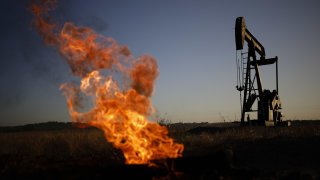
- Surging gasoline prices in the U.S. are showing signs of impact on consumption, according to one risk analyst.
- "We're starting to see some signs of demand destruction, particularly for gasoline, but it's really just off some of the highs of last year, when gasoline prices were much cheaper," said Rachel Ziemba, founder of Ziemba Insights, a research firm.
- Demand destruction refers to persistent high prices or tight supplies that eventually lead to a drop in demand, in this case, for energy products such as oil or gas.
Surging gasoline prices in the U.S. are showing signs of impact on consumption, according to one risk analyst.
WATCH ANYTIME FOR FREE
Stream NBC10 Boston news for free, 24/7, wherever you are. |
"We're starting to see some signs of demand destruction, particularly for gasoline, but it's really just off some of the highs of last year, when gasoline prices were much cheaper," Rachel Ziemba, founder of Ziemba Insights, a research firm, told CNBC's "Squawk Box Asia" on Monday.
Demand destruction refers to persistent high prices or tight supplies that eventually lead to a drop in demand, in this case, for energy products such as oil or gas.
Get updates on what's happening in Boston to your inbox. Sign up for our News Headlines newsletter.
"All these consumption metrics we look at are actually still higher now than they were this time in 2019, when gasoline prices were definitely cheaper, when a lot of other goods were cheaper. And when the U.S. economy was also in a fairly robust state," she explained.
Gasoline prices have been surging close to an average $5 per gallon across the U.S. While consumers are feeling the pain, prices are not yet at a level that would tip the economy into a recession, economists predict.
Money Report
President Joe Biden will make make a three-stop trip to the Middle East in mid-July that includes a visit to Saudi Arabia, one of the world's largest oil producers. He is expected to explore ways to bring more oil onto the global market, as the U.S. and other countries are face soaring fuel prices due to the war in Ukraine as well as post-pandemic demand. All that is driving up inflation.
"I think we were still dealing with the fact of an adjustment to the pandemic meant people were more likely to drive than take public transit, and people are still taking long haul journeys," said Ziemba.
"The fact that airplanes are starting to sort of reduce production, reduce flights… might mean some people are more likely to do road trips. I think on the margins, it costs a lot more to take those trips. And so we'll see some people who are going or staying closer to home, maybe stay patient," she added.
"But ultimately, this sort of pain point of higher prices is gonna take some time to play in."
In June, Biden called on U.S. oil refining companies to produce more, and said they need to help alleviate the burden of high prices on consumers.
"One sign I'm watching for is to what extent are we globally gonna see more refining capacity. There's been a little bit of good news there, but it's mostly been in emerging market countries adding some refining capacity," she said.
"I'm afraid comments from the White House blaming refineries, blaming gas stations don't necessarily help solve this problem."
Russia's war on Ukraine has pushed up oil prices, which have surged 43% year-to-date. The war and threats of sanctions on Russian coal and oil have roiled global markets, including energy markets.
The Group of 7 economies have floated the idea of a price cap on Russian oil to further squeeze the Kremlin's ability to fund its onslaught in Ukraine and try to protect consumers amid surging energy prices.
But energy analysts are skeptical of the proposal.
The real question ahead is what's going to happen with Russian crude, and "how the price versus volume issue is going to play out," Ziemba noted.
"I think this is gonna be something that's painful for U.S. consumers and global consumers," Ziemba said.






